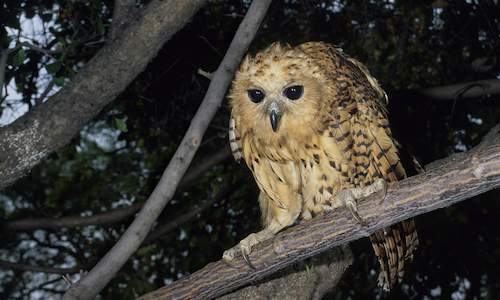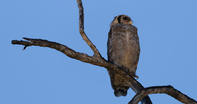
Verreaux's Eagle Owl
Name
Verreaux's Eagle Owl (Bubo lacteus)
Alternative name - Giant Eagle Owl
Appearance
The Verreaux's eagle owl is one the largest owls in the world. The Verreaux's eagle owl is easily recognised by its huge size and average 140 cm wingspan.
They are light grey in colour, finely barred blackish above and below but there are no heavy blotching. It is a pale sand colour underneath with streaks of dark brown or grey. The pale face is boldly outlined in black with a large powerful beak and large orange or yellow eyes.
The eyes look black at a distance and they have distinctive pink eyelids, which make them very identifiable. It is similar to the huge long-eared owl. Two ear tufts extend from over the eyes. Eagle owls have huge powerful feet and talons.
Verreaux's Eagle Owl Diet
The Verreaux's eagle owl is typically seen at dawn or dusk. It feeds largely on game birds such as guinea fowl or water birds like flamingoes and herons. They have a varied diet killing mammals the size of young vervet monkeys, hedgehogs and scrub hares. Prey is usually caught by quickly gliding down on to it from a perch.
Verreaux's Eagle Owl Breeding
The Verreaux's eagle owl will breed from March to September. The Verreaux's eagle owl is monogamous and will nest on an oversized nest, normally the nest of other raptors or sociable weavers, hammerkops or buffalo weavers. Two eggs are usually laid and both parents incubate for up to 39 days.
Verreaux's Eagle Owl Behaviour
The Verreaux's eagle owl are found along tree lining drainage lines and watercourses. Their call is a deep gruff hooting call ‘hryu hryu hooo’. They rarely hunt by day and roost in large trees, preferably in the shade.
Eagle Owl Habitat
The Verreaux's eagle owl is seen alone or in pairs and mainly from Kwazulu-Natal in South Africa northwards.
The Verreaux's eagle owl prefers woodland, savannah and tree-lined watercourses.
Where they are found
Verreaux's eagle owls are found in northern South Africa, Botswana, Zimbabwe, Namibia, and Mozambique.

Owls are divided into two main groups or families, the Strigidae and Tytonidae. The tytonids are screeching owls and include the grass and b...
more
 Owls are divided into two main groups or families, the Strigidae and Tytonidae. The tytonids are screeching owls and include the grass and b...
Owls are divided into two main groups or families, the Strigidae and Tytonidae. The tytonids are screeching owls and include the grass and b...